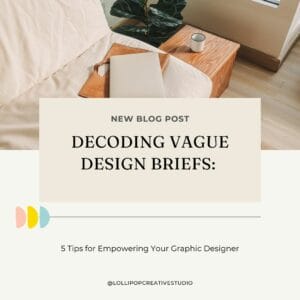*No designer wants to play a game of ‘Guess What’s in the Client’s Mind?’ By following these 5 powerful tips, you’ll empower your graphic designer to create awe-inspiring designs that align perfectly with your vision and captivate your audience!*
5 Tips to Write an EPIC Brief That Will Make Your Designer’s Heart Sing!
In the world of design, communication is key. Whether you’re embarking on a new branding project, creating marketing materials, or revamping your website, one thing is certain: a clear and effective design brief can make all the difference. But too often, clients provide vague or incomplete briefs, leaving designers scratching their heads and attempting to decipher their intentions. It’s time to put an end to the guessing game and empower your graphic designer to create designs that not only meet but exceed your expectations. Here are five tips to help you craft an EPIC design brief that will make your designer’s heart sing!
1. Be Clear and Concise: Ain’t Nobody Got Time for Guesswork!
Imagine embarking on a journey without a map. That’s what it feels like for a designer when they receive a brief that’s lacking in specifics. To set the stage for success, provide clear and concise details about your project. Outline your goals, target audience, and desired outcomes. The more precise your vision, the smoother the design process will be. Spare your designer the headache of guesswork, and offer them a roadmap to creativity.
2. Share Visual References: A Picture Is Worth a Thousand Words!
Sometimes, words alone can’t capture the essence of what you’re envisioning. This is where visual references come to the rescue. Show your designer examples of designs, color schemes, or mood boards that resonate with you. These visuals act as a bridge, helping your designer understand your aesthetic preferences with greater clarity. After all, a picture is worth a thousand words, and a well-chosen image can convey ideas that words might struggle to express.
3. Embrace Your Brand Voice & Tone: Let Your Brand’s Personality Shine!
Your brand has a unique personality, and it’s important to let it shine through in your designs. Clearly define your brand’s voice, tone, and style. Share any brand guidelines, including preferred language, messaging, and visual elements. When your designer is well-acquainted with your brand’s identity, they can create designs that not only look visually appealing but also encapsulate the essence of your brand.
4. Know Your Ideal Client: Understand Them Like the Back of Your Hand!
Every design should resonate with your target audience. To achieve this, communicate your ideal client’s demographics, interests, and preferences. The better your designer understands your audience, the more effectively they can make design choices that capture their attention. Think of your designer as your creative partner in crafting a message that speaks directly to your customers.
5. Embrace Collaborative Creativity: It’s a Team Effort!
Design is not a one-way street. Embrace a culture of collaboration and open communication with your designer. Encourage them to share their expertise, ask questions, and offer suggestions. The magic happens when your ideas intersect with their creative genius. By fostering an environment of teamwork, you’ll witness the synergy of your ideas and their artistic prowess resulting in design brilliance that truly stands out.
In conclusion, the art of crafting an effective design brief is a skill that pays dividends in the form of outstanding visuals that capture attention and convey messages powerfully. By following these five tips, you can elevate your collaboration with your graphic designer, ensure your vision is accurately translated into design, and ultimately create designs that leave a lasting impact on your audience. So, the next time you’re faced with the task of briefing your designer, remember: clarity, visuals, brand identity, audience insights, and collaborative creativity are your keys to success!





